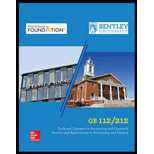
GB 112/212 MANAGERIAL ACC. W/ACCESS >C<
17th Edition
ISBN: 9781260218831
Author: Libby
Publisher: MCG CUSTOM
expand_more
expand_more
format_list_bulleted
Concept explainers
Textbook Question
Chapter 6, Problem 5MCQ
You have determined that Company X estimates bad debt expense with an aging of
- a. $180
- b. $250
- c. $210
- d. $230
Expert Solution & Answer
Want to see the full answer?
Check out a sample textbook solution
Students have asked these similar questions
Accurate Answer
Correct answer
Question
Chapter 6 Solutions
GB 112/212 MANAGERIAL ACC. W/ACCESS >C<
Ch. 6 - Prob. 1QCh. 6 - What is gross profit or gross margin on sales? In...Ch. 6 - What is a credit card discount? How does it affect...Ch. 6 - Prob. 4QCh. 6 - Prob. 5QCh. 6 - Differentiate accounts receivable from notes...Ch. 6 - Which basic accounting principle is the allowance...Ch. 6 - Using the allowance method, is bad debt expense...Ch. 6 - Prob. 9QCh. 6 - Prob. 10Q
Ch. 6 - Prob. 11QCh. 6 - Prob. 12QCh. 6 - Prob. 13QCh. 6 - Prob. 14QCh. 6 - Briefly explain how the total amount of cash...Ch. 6 - Prob. 16QCh. 6 - Sales discounts with terms 2/10, n/30 mean: a. 10...Ch. 6 - Gross sales total 300,000, one-half of which were...Ch. 6 - A company has been successful in reducing the...Ch. 6 - When a company using the allowance method writes...Ch. 6 - You have determined that Company X estimates bad...Ch. 6 - Prob. 6MCQCh. 6 - Which of the following is not a step toward...Ch. 6 - When using the allowance method, as bad debt...Ch. 6 - Which of the following best describes the proper...Ch. 6 - Prob. 10MCQCh. 6 - Prob. 6.1MECh. 6 - Prob. 6.2MECh. 6 - Recording Bad Debts Prepare journal entries for...Ch. 6 - Prob. 6.4MECh. 6 - Determining the Effects of Credit Policy Changes...Ch. 6 - Prob. 6.6MECh. 6 - Prob. 6.7MECh. 6 - Prob. 6.1ECh. 6 - Reporting Net Sales with Credit Sales, Sales...Ch. 6 - Reporting Net Sales with Credit Sales, Sales...Ch. 6 - Determining the Effects of Credit Sales, Sales...Ch. 6 - Prob. 6.5ECh. 6 - Reporting Bad Debt Expense and Accounts Receivable...Ch. 6 - Recording Bad Debt Expense Estimates and...Ch. 6 - Recording Bad Debt Expense Estimates and...Ch. 6 - Prob. 6.9ECh. 6 - Prob. 6.10ECh. 6 - Computing Bad Debt Expense Using Aging Analysis...Ch. 6 - Recording and Reporting a Bad Debt Estimate Using...Ch. 6 - Recording and Reporting a Bad Debt Estimate Using...Ch. 6 - Prob. 6.14ECh. 6 - Prob. 6.15ECh. 6 - Inferring Bad Debt Write-Offs and Cash Collections...Ch. 6 - Inferring Bad Debt Write-Offs and Cash Collections...Ch. 6 - Prob. 6.18ECh. 6 - Prob. 6.19ECh. 6 - Prob. 6.20ECh. 6 - Recording, Reporting, and Evaluating a Bad Debt...Ch. 6 - Prob. 6.22ECh. 6 - Prob. 6.23ECh. 6 - Interpreting tho Effects of Salos Declines and...Ch. 6 - Prob. 6.25ECh. 6 - Prob. 6.26ECh. 6 - Prob. 6.27ECh. 6 - Prob. 6.1PCh. 6 - Recording Bad Debts and Interpreting Disclosure of...Ch. 6 - Determining Bad Debt Expense Based on Aging...Ch. 6 - Preparing an Income Statement and Computing the...Ch. 6 - Prob. 6.5PCh. 6 - Prob. 6.6PCh. 6 - Prob. 6.7PCh. 6 - Reporting Net Sales and Expenses with Discounts,...Ch. 6 - Prob. 6.2APCh. 6 - Determining Bad Debt Expense Based on Aging...Ch. 6 - Prob. 6.4APCh. 6 - Prob. 6.5APCh. 6 - Prob. 6.1CONCh. 6 - Finding Financial Information Refer to the...Ch. 6 - Finding Financial Information Refer to the...Ch. 6 - Prob. 6.3CPCh. 6 - Prob. 6.4CPCh. 6 - Prob. 6.5CP
Knowledge Booster
Learn more about
Need a deep-dive on the concept behind this application? Look no further. Learn more about this topic, accounting and related others by exploring similar questions and additional content below.Similar questions
arrow_back_ios
SEE MORE QUESTIONS
arrow_forward_ios
Recommended textbooks for you
- Principles of Accounting Volume 1AccountingISBN:9781947172685Author:OpenStaxPublisher:OpenStax College
 Financial And Managerial AccountingAccountingISBN:9781337902663Author:WARREN, Carl S.Publisher:Cengage Learning,
Financial And Managerial AccountingAccountingISBN:9781337902663Author:WARREN, Carl S.Publisher:Cengage Learning, Cornerstones of Financial AccountingAccountingISBN:9781337690881Author:Jay Rich, Jeff JonesPublisher:Cengage Learning
Cornerstones of Financial AccountingAccountingISBN:9781337690881Author:Jay Rich, Jeff JonesPublisher:Cengage Learning  Financial AccountingAccountingISBN:9781337272124Author:Carl Warren, James M. Reeve, Jonathan DuchacPublisher:Cengage Learning
Financial AccountingAccountingISBN:9781337272124Author:Carl Warren, James M. Reeve, Jonathan DuchacPublisher:Cengage Learning

Principles of Accounting Volume 1
Accounting
ISBN:9781947172685
Author:OpenStax
Publisher:OpenStax College

Financial And Managerial Accounting
Accounting
ISBN:9781337902663
Author:WARREN, Carl S.
Publisher:Cengage Learning,

Cornerstones of Financial Accounting
Accounting
ISBN:9781337690881
Author:Jay Rich, Jeff Jones
Publisher:Cengage Learning

Financial Accounting
Accounting
ISBN:9781337272124
Author:Carl Warren, James M. Reeve, Jonathan Duchac
Publisher:Cengage Learning
Accounts Receivable and Accounts Payable; Author: The Finance Storyteller;https://www.youtube.com/watch?v=x_aUWbQa878;License: Standard Youtube License